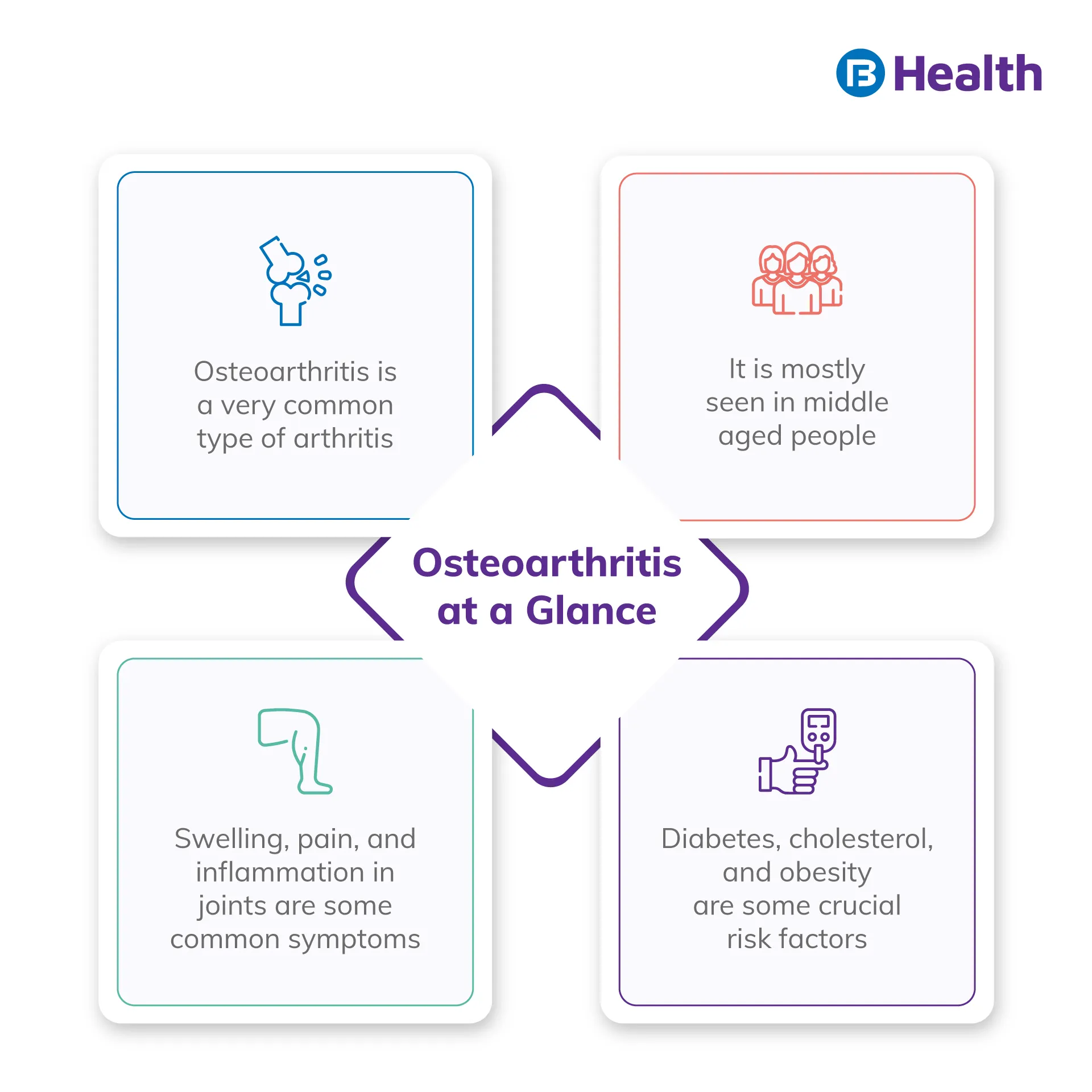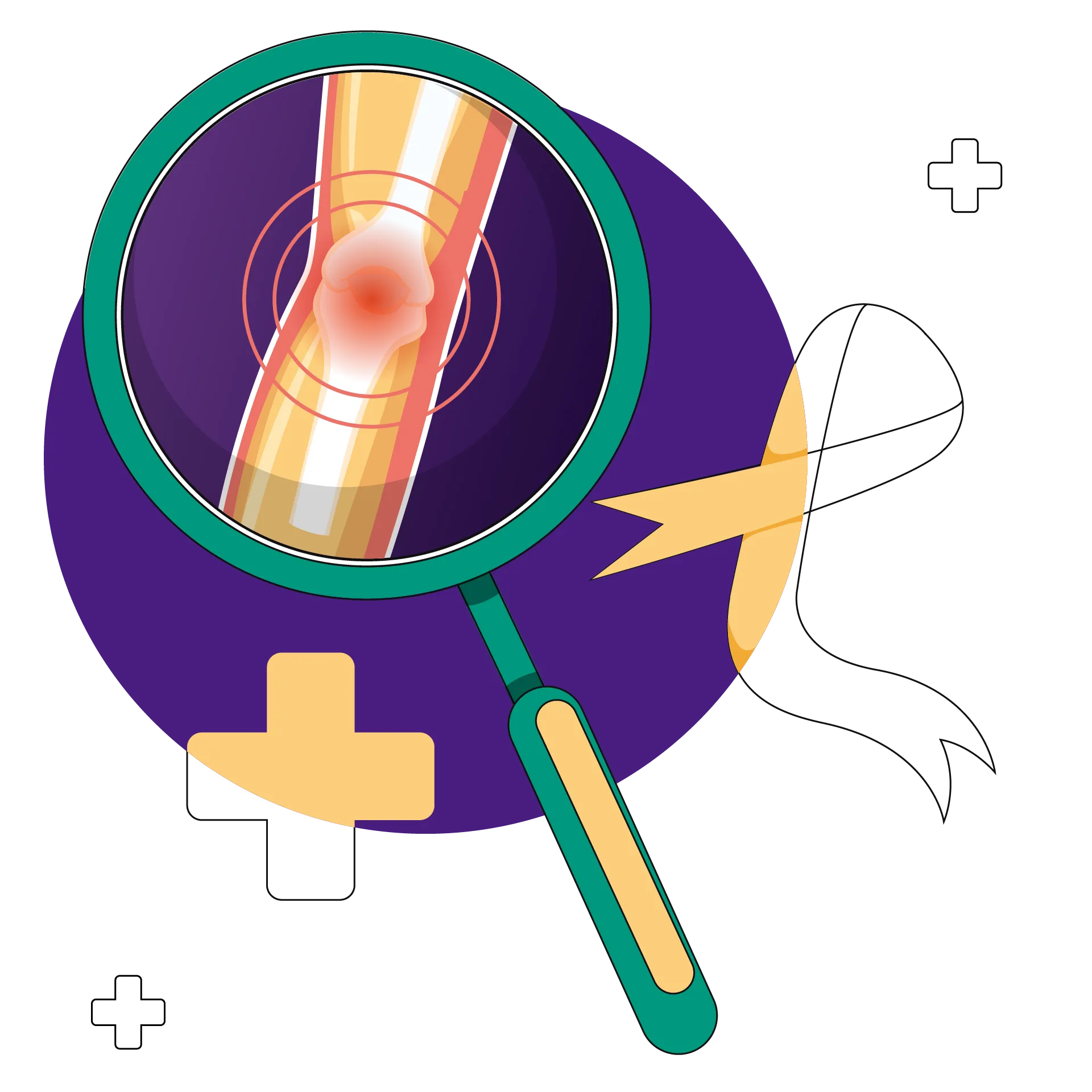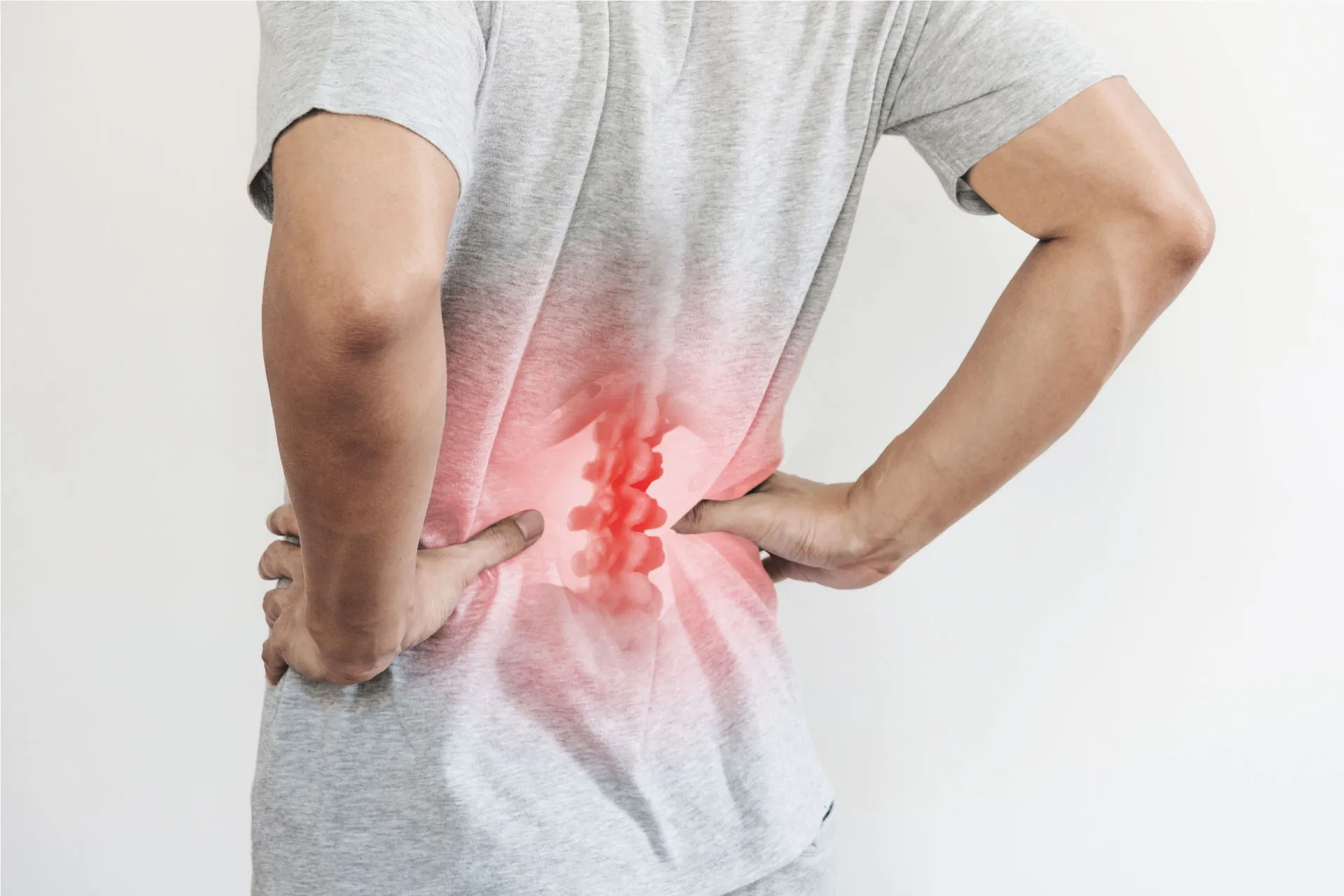Orthopedic | 7 min read
Osteoarthritis: Symptoms, Risk Factor and Treatment
Medically reviewed by
Table of Content
Synopsis
The most prevalent kind of arthritis is osteoarthritis, sometimes referred to as wear and tear arthritis. It frequently affects the weight-bearing joints in the spine, hips, and knees. Osteoarthritis also impacts the neck, fingers, big toe, and thumb.
Key Takeaways
- Osteoarthritis is a very common type of arthritis
- Mainly middle-aged people suffer from this abnormality
- Weight control, regular exercise, and surgery are some methods to cure osteoarthritis
Osteoarthritis is the most frequent chronic joint disease (OA). Other names for Osteoarthritis include degenerative arthritis, wear-and-tear arthritis, and degenerative joint disease. The most common kind of arthritis is Osteoarthritis, often known as a degenerative joint disease (DJD). As people become older, Osteoarthritis is more likely to occur. Though there are occasional exceptions, osteoarthritis changes often take place gradually over a long period of time. Joint inflammation and damage result in bone alterations and the degeneration of tendons, ligaments, and cartilage, which cause pain, swelling, and deformity of the joint. Any joint in the body can causes Osteoarthritis.
However, joints like knees and feet that support most of our weight are more likely to be affected. Additionally, frequently used joints, such as the hand joints, are also commonly impacted. Read to know about osteoarthritis causes, symptoms, and treatment.
Osteoarthritis: Two Primary Forms
Primary
The fingers, thumbs, spine, hips, knees, and great (large) toes are the commonly affected body parts.
Secondary
Occurs in conjunction with a pre-existing joint abnormality. These may include a repetitive or sports-related injury or trauma, inflammatory arthritis, infectious arthritis, joint metabolic diseases, congenital joint disorders, or joint genetic disorders (such as Ehlers-Danlos, commonly referred to as hypermobility or "double-jointed").
Additional read: Bursitis: Type, Causes and Symptoms
Who is Affected by Osteoarthritis?
On X-ray, Osteoarthritis is observed in around 80% [1] of people older than 55 years. However, only 60% of them have symptoms. In addition, over 30 million people in the United States are believed to have symptoms of Osteoarthritis. Compared to males, post-menopausal women have a higher prevalence of knee osteoarthritis.
Risk Factors for Osteoarthritis
Numerous other risk factors, including obesity, diabetes, high cholesterol, gender, and heredity, raise the likelihood of Osteoarthritis in addition to age and secondary osteoarthritis causes such as inflammatory arthritis and past trauma/injury.
Obesity
- Obesity increases the risk of Osteoarthritis, particularly in the knee. In addition to stressing the body's weight-bearing mechanisms, obesity also has pro-inflammatory and metabolic consequences that have been associated with Osteoarthritis
- For individuals who are at risk, maintaining a healthy weight or decreasing excess weight is crucial
Diabetes and Hyperlipidemia
- By increasing the inflammatory response in the body, diabetes and hyperlipidemia (high lipids/cholesterol) increase the chances of developing Osteoarthritis
- Oxidation of lipids (fat compounds) can also lead to deposits in cartilage that obstruct the blood flow to the subchondral bone (the bone that sits under cartilage)
- The body produces more free radicals as a result of high blood sugar levels and high cholesterol/lipid levels, and this surpasses the resistance capacity of a cartilage
- Managing diabetes and hyperlipidemia (high amount of fat in the blood) is essential for bone health, along with general wellness
- Post-menopausal women's decreased estrogen increases knee Osteoarthritis
- As those born with certain bone illnesses or genetic features may be more prone to develop Osteoarthritis, heredity can play a part in the development of Osteoarthritis. Conditions like Ehlers-Danlos syndrome, which causes loose or hypermobile joints, might aggravate Osteoarthritis

What Causes Osteoarthritis?
Osteoarthritis causes are still unknown. However, we know that your chance of developing Osteoarthritis relies on many variables and is not just caused by 'wear and tear.'
Osteoarthritis causes are as follows:
Age
- Osteoarthritis often first manifests in people in their late 40s. This could result from age-related physical changes, including weight increase, weakened muscles, and a decreased capacity for self-healing
Gender
- More severe forms of Osteoarthritis is seen in females rather than men
Obesity
- Osteoarthritis is significantly influenced by being overweight, particularly in weight-bearing joints like the knee and the hip
Joint Injury
- Osteoarthritis in a joint may result from a severe accident or a procedure. Regular activity and exercise don't cause Osteoarthritis, but physically demanding employment or strenuous, repeated activities might increase the risk
Joint Abnormalities
- It can cause Osteoarthritis to develop earlier and with more severity, if you were born with abnormalities or acquired them as a kid
Genetic Factors
- Our inherited genes can influence the probability of developing Osteoarthritis in the hand, knee, or hip. Mutations can impact collagen protein in a few rare cases
Climatic Conditions
- Changes in the weather are often shown to exacerbate osteoarthritis pain. For example, when the air pressure drops. Although it doesn't cause arthritis, the weather might impact its symptoms
Diet
- Some people discover that particular meals make their pain and other symptoms worse or better. However, your weight is more likely to influence your chance of getting Osteoarthritis than any other particular dietary element.
Symptoms of Osteoarthritis
Osteoarthritis's primary symptoms are pain and, occasionally, stiffness in the afflicted joints. The pain is typically worse when you move the joint or towards the end of the day. After resting, your joints could feel stiff, but if you start moving, this passes typically quickly. There may be random variations in symptoms. Alternatively, you could discover that your symptoms change based on your actions.
Sometimes, the afflicted joint can enlarge, and the swelling might be due to the following:
- Development of an additional bone
- Thickening of the joint lining
- An increase in the fluid inside the joint capsule
Crepitus happens when you have difficulty moving your joint, and moving it makes grinding or crackling noises.
The muscles around the joint might occasionally appear withered or lanky. In addition, the joint may sometimes give way because of weakening muscles or a less stable joint structure.
Additional read: Scoliosis: How It Affects Your Well-beingHow do I Know if I have Osteoarthritis?
Osteoarthritis pain typically occurs gradually over many months or years, unlike other kinds of arthritis. It frequently worsens with joint-stressing activities like jogging or protracted walking.
In certain cases, especially in more severe illnesses, damaged joints may feel like crushing or grinding. However, prolonged morning stiffness is not a major OA symptom compared to inflammatory arthritides like rheumatoid or psoriatic arthritis, such as Osteoarthritis.
Normal symptoms of Osteoarthritis do not include fevers, weight loss, or very hot and red joints. Instead, these characteristics imply the presence of another disease or kind of arthritis.
Osteoarthritis is identified by a healthcare practitioner (MD, DO, NP, PA) after thoroughly reviewing your medical history and looking at your joints. X-rays can be helpful to ensure there is no other cause for discomfort. In most situations, magnetic resonance imaging (MRI) is not required unless there are exceptional conditions or suspicion of cartilage or surrounding ligament rupture.
Osteoarthritis cannot be diagnosed with blood tests. However, depending on how swollen a joint is, a doctor might drain fluid from it. This fluid can be tested to search for signs of other kinds of arthritis, such as gout. Online doctor consultation is available for OA.
Osteoarthritis Treatment:
Osteoarthritis therapy depends on your symptoms. It will also be determined by the requirements and the degree of your OA at the time of diagnosis.
The majority of clinicians start OA therapy with easy, non-invasive methods. The term 'non-invasive' refers to a therapy that does not entail inserting any medical tool into the body.
It is impossible to treat Osteoarthritis. A mix of pharmaceutical and non-pharmacological therapies often works effectively to control mild to severe symptoms. Medical interventions and advice include:
- Proper Medication
- Exercise
- Weight loss
- Healthy Food Habits
- Injection Therapy
A lower incidence of all fractures, as well as the hip, forearm, and bone fractures, have been linked to OA. As more time passes after the diagnosis of OA, the risk of fractures generally trends downward.
Usually, arthritis is not diagnosed with a bone density test. Instead, it's more frequently utilized to identify early indications of bone loss or osteoporosis. However, inflammatory forms of arthritis, such as Rheumatoid Arthritis (RA) or Psoriatic Arthritis (PsA), may put you at risk for osteoporosis.Bajaj Finserv Health provides personalized healthcare services for you and your family. From scheduling appointments to set up reminders, we can help you with all!
References
- https://www.ncbi.nlm.nih.gov/pmc/articles/PMC4647192/
Disclaimer
Please note that this article is solely meant for informational purposes and Bajaj Finserv Health Limited (“BFHL”) does not shoulder any responsibility of the views/advice/information expressed/given by the writer/reviewer/originator. This article should not be considered as a substitute for any medical advice, diagnosis or treatment. Always consult with your trusted physician/qualified healthcare professional to evaluate your medical condition. The above article has been reviewed by a qualified doctor and BFHL is not responsible for any damages for any information or services provided by any third party.





